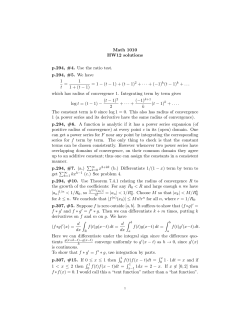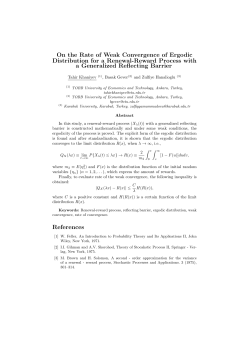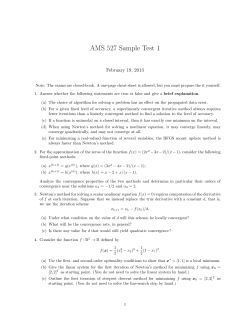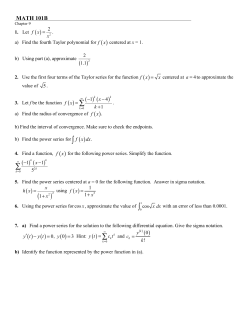
Making an ALARP Decision of Sufficient Testing
Making an ALARP Decision of Sufficient Testing (HASE’14) Mahnaz Malekzadeh mahnaz.malekzadeh@mdh.se Mälardalen Real-Time Research Center Mälardalen University Outline ● Motivation ● Worst-Case Timing Properties ● System Model ● ALARP ● Convergence Algorithm ● Motivational Example ● Evaluation ● Conclusion 2 Safety-Critical Systems ● Failure can lead to catasrophic damage to people or environment. * ** *** 3 Motivation ● Testing is an extremely important part of development and certification process. ● However, it is also one of the most expensive ones. Development*Cycle* Design$ 24%$ 45%$ 6%$ Requirements$ System$Tes7ng$ 5%$ 20%$ Acceptance$Tes7ng$ 4 Motivation ● Therefore, testers have to determine whether there is any benefit in running the current testing strategy further. ● To date research effort has been mainly focused on diverse testing strategies. ● However, it leaves an open issue of when to stop testing. 5 Motivation ● Test Process Challenges QUALITY COST How to make a decision to stop testing a system? 6 Motivation ● Such a decision also plays an important role for As Low As Reasonable Practicable (ALARP) principle. ● The concept of “reasonably practicable” lies at the heart of the British health and safety system. ● It is a key part of the general duties of the Health and Safety at Work etc. Act 1974. 7 Motivation ● Risk tolerability depends on practicability of further risk reduction. ● It must be feasible to demonstrate that cost of reducing the risk further would outweight the benefit gained. ● ALARP: Currently, this is at best a qualitative decision. ● We address this decision challenge quantitatively for the worst-case timing properties of safety-critical systems. 8 Outline ● Motivation ● Worst-case Timing Properties ● System Model ● ALARP ● Convergence Algorithm ● Motivational Example ● Evaluation ● Conclusion 9 Worst-Case Response Time ● Safety-critical systems: Extremely important to respond in a timely manner, e.g., the car braking system. ● They have to respond no later than a specific amount of time called ”deadline”. ● i.e, their Worst-Case Response Time (WCRT) has to be less than or equal to their deadline. WCRT ✓ WCRT ✗ time deadline 10 Why WCRT? ● Traditional Response Time Analysis techniques are based on simplified assumtions of systems and exact Worst-Case Execution Time (WCET). ● Incapable of capturing features inhabiting complex real-world safety-critical systems. ● Thus, resulting in inaccurate worst-case timing analysis. ● In contrary, our approach based on testing allows us to not to depend on an abstract model of a system nor the exact WCET. ● Thus, makes it interesting for real-world scenarios. 11 Outline ● Motivation ● Worst-Case Timing Properties ● System Model ● ALARP ● Convergence Algorithm ● Motivational Example ● Evaluation ● Conclusion 12 System Model A1 t11 t12 t13 t21 A2 t22 ● A set of applications (Ai) running on execution platform. ● Each application has a set of tasks (tij) scheduled for execution based on their deadline. 13 Task Set Simulator ● Task set simulator is used that allows long simulation time. ● It establishes two ground truths: ü Static WCRT, ü High Water Mark (HWM) achieved by significantly long simulation time. 14 Outline ● Motivation ● Worst-Case Timing Properties ● System Model ● ALARP ● Convergence Algorithm ● Motivational Example ● Evaluation ● Conclusion 15 ALARP ● The definition set out by the Court of Appeal: “‘Reasonably practicable’ is a narrower term than ‘physically possible’ … a computation must be made by the owner in which the quantum of risk is placed on one scale and the sacrifice involved in the measures necessary for averting the risk (whether in money, time or trouble) is placed in the other, and that, if it be shown that there is a gross disproportion between them – the risk being insignificant in relation to the sacrifice – the defendants discharge the onus on them.” 16 ALARP ● In essence, making sure a risk has been reduced ALARP is about weighing the risk against the sacrifice needed to further reduce it. ● Extreme examples: ● Disproportionate: To spend £1m to prevent five staff suffering bruised knees. ● Proportionate: To spend £1m to prevent a major explosion capable of killing 200 people. 17 ALARP Triangle High Risk Risk can not be tolerated (safety-critical tasks) Intolerable region Risk Risk is tolerable only if cost of further risk reduction is grossly inappropriate to the benefit attained (Risk-tolerable tasks) ALARP or Tolerable region Medium Risk Broadly acceptable region Low Risk Negligible risk 18 Outline ● Motivation ● Worst-Case Timing Properties ● System Model ● ALARP ● Convergence Algorithm ● Motivational Example ● Evaluation ● Conclusion 19 Convergence Algorithm When Maximum Observed Response Time (MORT) is not changing? • We never know this but may have suggestions. • By looking at whether a response times distribution model is changing. 20 Convergence Algorithm Main techniques the testing info. is used for: ü High Watermark (HWM), MORT, ü Statistical techniques, i.e. Kullback-Leibler DIVergence (KL DIV) test. Test Vectors Software Under Test HWM Response Times KL DIV 21 Convergence Algorithm ü MORT is not increasing (HWM), ü Nature of the response time distibution is not changing (KL DIV), More testing of the same nature is not going to reveal further useful information. 22 Convergence Algorithm Test Vectors Software Under Test Response Times BinSize = λ X = ResponseTimeEachTaskAfterTime_t Y=α*X+β Counter >= i Counter++ Passed Yes HWM Not Passed No Counter = 0 KL DIV < δ Passed END t=t+Δ Not Passed 23 Binning Response Times t2 t3 λ t1 t4 λ t2 λ t3 Binning: ü Simulator for scalability, ü Convergence algorithm to avoid the outliers affect the test result. 24 Outline ● Motivation ● Worst-Case Timing Properties ● System Model ● ALARP ● Convergence Algorithm ● Motivational Example ● Evaluation ● Conclusion 25 Motivational Exmple −4 6 4 x 10 x 10 3.9 KL DIV MORT −6 x 10 (a) KL DIV 8 2 0 1000 KL DIV 3.7 4 0 0 MORT 3.8 KL DIV 4 0 2000 400 800 Testing Time 3000 4000 1200 5000 6000 Testing Time 7000 8000 9000 3.6 10000 26 Outline ● Motivation ● Worst-Case Timing Properties ● System Model ● ALARP ● Convergence Algorithm ● Motivational Example ● Evaluation ● Conclusion 27 Evaluation Criteria: ü Closeness of the algorithm Stopping Point MORT (SPMORT) to the Last MORT (LM) seen in simulation, ü Closeness of SPMORT to a quantified MORT called ALARP MORT (AM). Algorithm Achievement (AA) Algorithm Effort (AE) 28 Evaluation (a) High priority task LM SP 3861.5 3861 0AM HWM 100 50 150 4 MORT x 10 4 AM SP 200 250 Testing Time (b) Low priority task 300 350 400 LM HWM 3 2 Algorithm Effort Algorithm Achievement MORT 3862 0 500 1000 1500 2000 2500 3000 3500 Testing Time (c) Normalized algorithm achievement for task set 4000 4500 5000 100 100.5 10 5 0 96 96.5 97 97.5 98 98.5 99 Bins (d) Normalized algorithm effort for task set 99.5 20 10 0 0 0.2 0.4 0.6 0.8 1 Bins 1.2 1.4 1.6 1.8 2 4 x 10 29 Evaluation (a) High priority task ü AM (2, 3861) ü LM (210, 3862) ü SP (378, 3862) (b) Low priority task ü AM (194, 36259) ü LM (4774, 37087) ü SP (378, 36259) ü AA (99.95) in the range [96, 100] ü AE (1011) in the range [0, 20000] 30 Outline ● Motivation ● Worst-Case Timing Properties ● System Model ● ALARP ● Convergence Algorithm ● Motivational Example ● Evaluation ● Conclusion 31 Conclusion ü The algorithm performs well, that is, testing stopped after the point at which new significant information may not achieved at justifiable cost (ALARP). ü Can ensure safe worst-case response time (different criteria for different criticality). Future work: • To improve the performance and scalability. • To investigate how the algorithm can be tuned for robustness. 32 Thank You 33 References * [Photograph] Retrieved from: http://www.ainonline.com/sites/default/files/uploads/ 524_saabgripen_pic1.jpg ** [Photograph] Retrieved from: http://www.carpriceinindia.in/blog/wp-content/ uploads/2012/07/Volvo-Looking-To-Be-No-3-LuxuryCar-Dealer-In-India-In-2020.jpg *** [Photograph] Retrieved from: http://www.bombardier.com/content/dam/Websites/ bombardiercom/News/import/883-bombardier-sifangwins-contract-to-build-80-very-high-speed-trains-forchina-3.jpg/_jcr_content/renditions/original 34
© Copyright 2025









